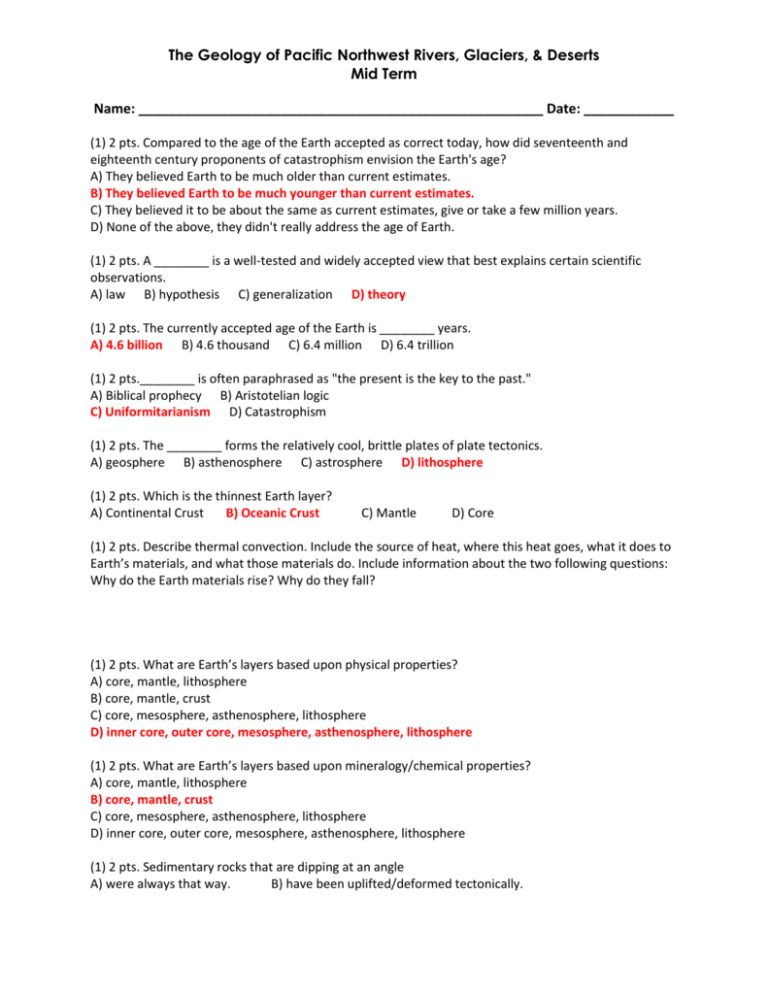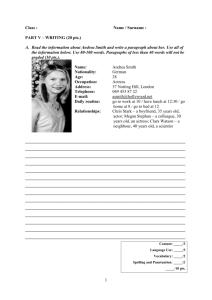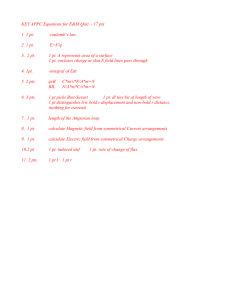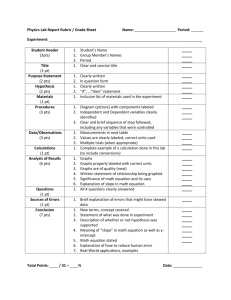GEO144_mid_term_I_so..
advertisement

The Geology of Pacific Northwest Rivers, Glaciers, & Deserts Mid Term Name: ______________________________________________________ Date: ____________ (1) 2 pts. Compared to the age of the Earth accepted as correct today, how did seventeenth and eighteenth century proponents of catastrophism envision the Earth's age? A) They believed Earth to be much older than current estimates. B) They believed Earth to be much younger than current estimates. C) They believed it to be about the same as current estimates, give or take a few million years. D) None of the above, they didn't really address the age of Earth. (1) 2 pts. A ________ is a well-tested and widely accepted view that best explains certain scientific observations. A) law B) hypothesis C) generalization D) theory (1) 2 pts. The currently accepted age of the Earth is ________ years. A) 4.6 billion B) 4.6 thousand C) 6.4 million D) 6.4 trillion (1) 2 pts.________ is often paraphrased as "the present is the key to the past." A) Biblical prophecy B) Aristotelian logic C) Uniformitarianism D) Catastrophism (1) 2 pts. The ________ forms the relatively cool, brittle plates of plate tectonics. A) geosphere B) asthenosphere C) astrosphere D) lithosphere (1) 2 pts. Which is the thinnest Earth layer? A) Continental Crust B) Oceanic Crust C) Mantle D) Core (1) 2 pts. Describe thermal convection. Include the source of heat, where this heat goes, what it does to Earth’s materials, and what those materials do. Include information about the two following questions: Why do the Earth materials rise? Why do they fall? (1) 2 pts. What are Earth’s layers based upon physical properties? A) core, mantle, lithosphere B) core, mantle, crust C) core, mesosphere, asthenosphere, lithosphere D) inner core, outer core, mesosphere, asthenosphere, lithosphere (1) 2 pts. What are Earth’s layers based upon mineralogy/chemical properties? A) core, mantle, lithosphere B) core, mantle, crust C) core, mesosphere, asthenosphere, lithosphere D) inner core, outer core, mesosphere, asthenosphere, lithosphere (1) 2 pts. Sedimentary rocks that are dipping at an angle A) were always that way. B) have been uplifted/deformed tectonically. The Geology of Pacific Northwest Rivers, Glaciers, & Deserts Mid Term C) are younger than the fault that cut them. E) A & B F) B & C G) B & D D) are older than the fault that cut them. (1) 2 pts. What happens to oceanic crust as it gets older, in the correct order? A) crust cools, becomes more dense, and sinks B) crust becomes more dense and sinks C) crust gets more dense, cools, and rises D) crust heats, becomes less dense, and rises (1) 2 pts. Which is the most dense? A) continental crust B) oceanic crust C) core D) mantle (1) 2 pts. Which is the least dense? A) continental crust B) oceanic crust C) core D) mantle (1) 2 pts. In the diagram below, label each illustration with the correct type of volcano. Fissure Volcano, Stratovolcano, Shield Volcano, and Caldera Volcano A) Caldera Volcano B) Fissure Volcano C) Stratovolcano D) Shield Volcano (1) 2 pts. In the above examples, which is volcano has the highest Silica content? A) Fissure Volcano B) Stratovolcano C) Shield Volcano D) Caldera Volcano (1) 2 pts. In the above examples, which is volcano has the lowest Silica content? A) Fissure Volcano B) Stratovolcano C) Shield Volcano D) Caldera Volcano (1) 2 pts. Which of the following best describes the fundamental concept of cross cutting relations? A) Rocks are younger than a fault if they are cut by the fault. B) Processes that cut across geological units are older than those geological units. C) Processes that cut across geological units are younger than those geological units. D) Fossils are younger than a fault if they are cut by the fault. (1) 2 pts. The Geologic Time Scale divisions are based on ________. A) equal divisions of 1 million (era), 50,000 (period), and 5,000 (epoch) intervals B) major climatic shifts C) doctrine of catastrophism D) none of the above (1) 2 pts. In correct order from the center outward, Earth includes which units? A) inner core, crust, mantle, hydrosphere B) core, crust, mantle, hydrosphere C) core, inner mantle, outer mantle, crust D) inner core, outer core, mantle, crust (1) 2 pts. The asthenosphere is actually a part of the ________ of the Earth. The Geology of Pacific Northwest Rivers, Glaciers, & Deserts Mid Term A) outer core B) inner core C) crust D) mantle (1) 2 pts.________ rocks form by crystallization and consolidation of molten magma. A) Igneous B) Primary C) Sedimentary D) Indigenous (1) 2 pts.________ rocks always originate at the surface of the solid Earth. A) Secondary B) Sedimentary C) Igneous D) Metamorphic (1) 2 pts.________ is the process by which rocks break down in place to produce soils and sediments. A) Subduction B) Lithification C) Weathering D) Metamorphism (1) 2 pts. Which one of the following statements is NOT correct? A) Sedimentary rocks may weather to igneous rocks. B) Igneous rocks can undergo metamorphism. C) Magmas crystallize to form igneous rocks. D) Metamorphic rocks may melt to magma. (1) 2 pts. Oceanic crust is thicker than continental crust. T/F (1) 2 pts. The currently accepted age of the Earth is approximately 4.5 million years. T/F (1) 2 pts. A scientific theory is a tentative or untested explanation that is proposed to explain scientific observations. T/F (1) 2 pts. Internally, the Earth consists of spherical shells with different compositions and densities. T/F (1) 2 pts. The asthenosphere is a relatively cool and rigid shell that overlies the lithosphere. T/F (1) 2 pts. According to the rock cycle, any type of rock (igneous, sedimentary, or metamorphic) may be transformed into another type of rock, given enough time. T/F (1) 2 pts. Igneous rocks are produced largely by the deposition and consolidation of surface materials like sand and mud. T/F (1) 2 pts. An unconformity is a buried ________. A) surface of erosion separating younger strata above from older strata below B) fault or fracture with younger strata above and older strata below C) surface of erosion with older strata above and younger strata below D) fault or fracture with older rocks above and younger rocks below (1) 2 pts. Which of the following best characterizes an angular unconformity? A) Horizontal lava flows lie below the unconformity, and horizontal, sedimentary strata lie above. B) Tilted strata lie below the unconformity with loose, unconsolidated soil above. C) Tilted strata lie below the unconformity, and bedding in younger strata above is parallel to the unconformity. D) It is the discordant boundary between older strata and an intrusive body of granite. (1) 2 pts. Visualize five horizontal sedimentary strata exposed in a cliff or canyon wall identified by consecutive numbers, 1 being the lowest bed and 5 being the highest. Which of the following statements concerning the strata are TRUE? A) bed 5 is the oldest B) bed 3 is older than beds 2 and 4 C) beds l and 3 are older than bed 4 D) bed 4 is older than bed 2 The Geology of Pacific Northwest Rivers, Glaciers, & Deserts Mid Term (1) 2 pts. By applying the law of superposition ________ ages can be determined. A) relative B) conventional C) radiometric D) both relative and radiometric (1) 2 pts. ________ is an erosional contact between tilted, older strata below and horizontal, younger strata above. A) A disconformity B) Cross cutting C) An angular unconformity D) Inverse bedding (1) 2 pts. Sandstone strata and a mass of granite are observed to be in contact. Which of the following statements is correct geologically? A) The sandstone is younger if it shows evidence of contact metamorphism. B) The granite is older if it contains inclusions of sandstone. C) The granite is older if the sandstone contains pebbles of the granite. D) The sandstone is younger if the granite contains sandstone inclusions. (1) 2 pts. Assume that you have just examined several flat-lying sedimentary layers. After much study you determine that there is a considerable span of time for which no sedimentary rock layer exists at this site. You have just discovered a(n) ________. A) disconformity B) example of cross-cutting relationships C) series of conformable strata D) angular unconformity (1) 2 pts. What fundamental concept states that in a horizontal sequence of conformable sedimentary strata, each higher bed is younger than the bed below it? A) theory of correlative deposition B) law of original correlation C) law of superposition D) theory of superstition (1) 2 pts. The half-life of carbon-14 is about 6000 years. Assume that a sample of charcoal formed by burning of living wood 15,000 years ago. How much of the original carbon-14 would remain today? A) between 33% and 50% B) between 25% and 50% C) more than 50% D) between 12.5% and 25% (1) 2 pts. A disconformity is an erosional unconformity with parallel beds or strata above and below. T/F (1) 2 pts. An unconformity involving older metamorphic rocks and younger sedimentary strata is termed a nonconformity. T/F (1) 2 pts. Phanerozoic, marine, sedimentary strata of the same age on different continents can usually be correlated by their fossil assemblages. T/F (1) 2 pts. The percentage of radioactive atoms that decay during one half-life is always the same. T/F (1) 2 pts. After two half-lives there is no longer any of the original radioactive material remaining. T/F (1) 2 pts. After three half-lives, one-ninth of an original, radioactive parent isotope remains and eightninths has decayed into the daughter isotope. T/F (1) 2 pts. In the chart of radioactive decay shown below: (a) how many half-lives have elapsed by this time? __2__ (b) how many half-lives have elapsed by this time? __3__ The Geology of Pacific Northwest Rivers, Glaciers, & Deserts Mid Term (1) 2 pts. In the early part of the twentieth century, ________ argued forcefully for continental drift. A) Karl Wagner B) Bill Kohl C) Peter Rommel D) Alfred Wegener (1) 2 pts. The late Paleozoic supercontinent is known as ________. A) Panatopia B) Pangaea C) Pandomonia D) Pancakea (1) 2 pts. All of the following are evidence supporting the theory of plate tectonics EXCEPT for ________. A) hot spots B) paleomagnetism C) ocean floor drilling D) changes in the Moon's orbit due to shifting plates (1) 2 pts. Which of the following energy sources is thought to drive the lateral motions of Earth's lithospheric plates? A) electrical and magnetic fields localized in the inner core B) swirling movements of the molten iron particles in the outer core C) export of heat from deep in the mantle to the top of the asthenosphere D) gravitational attractive forces of the Sun and Moon (1) 2 pts. Pull-apart rift zones are generally associated with a ________ plate boundary. A) convergent B) divergent C) transform D) all plate boundaries (1) 2 pts. New oceanic crust and lithosphere are formed at ________. A) divergent boundaries by submarine eruptions and intrusions of basaltic magma B) convergent boundaries by submarine eruptions and intrusions of basaltic magma C) divergent boundaries by submarine eruptions and intrusions of rhyolitic magma The Geology of Pacific Northwest Rivers, Glaciers, & Deserts Mid Term D) convergent boundaries by submarine eruptions and intrusions of rhyolitic magma (1) 2 pts. The volcanoes and deep valleys of east Africa are related to a ________. A) continental collision zone between Africa and the Zagros Mountains along the southern margin of Eurasia B) transform fault aligned with the Red Sea carrying the Arabian and African blocks in opposite directions C) continental rift along which parts of the African continent are beginning to slowly separate D) fault allowing Arabia to slip westward past east Africa and penetrate into Turkey (1) 2 pts. Cooler, older, oceanic lithosphere sinks into the mantle at ________. A) transform fault zones along divergent plate boundaries B) subduction zones along convergent plate boundaries C) rift zones along mid-ocean ridges D) sites of long-lived, hot spot volcanism in the ocean basins (1) 2 pts. The ________ is an example of an active, continent-continent collision. A) westward movement of the South American plate over the Nazca plate B) Arabian Peninsula slamming into North Africa under the Red Sea C) northern movement of Baja California and a sliver of western California toward the Hawaiian Islands D) northward movement of India into Eurasia (1) 2 pts. Linear, magnetic patterns associated with mid-ocean ridges are configured as ________. A) reversed magnetizations along the rift valleys and normal magnetizations along the ridge B) normal and reversed magnetized strips roughly parallel to the ridge C) normal and reversed magnetized strips roughly perpendicular to the ridge axis D) concentric circles about a rising plume of hot mantle rocks and magma (1) 2 pts. The energy for Plate Tectonics comes from A) the magnetic field of the earth B) heat from the sun C) gravity between the earth and moon D) ocean currents E) heat from the earth's core (1) 2 pts. The Himalayas are associated with which of the following plate boundaries? A) Ocean-continental convergence B) Ocean-ocean convergence C) Continent-continent convergence D) Divergent E) Transform Fault (1) 2 pts. The Hawaiian Islands are an example of: A) Two Ocean plates converging B) Two Continental plates converging C) Diverging plates D) Hot Spots The Geology of Pacific Northwest Rivers, Glaciers, & Deserts Mid Term E) Transform Fault Boundary (1) 2 pts. The youngest seafloor rocks are found: A) nearest to the mid-ocean ridges B) nearest to the continental shelves C) evenly distributed throughout the ocean D) underneath the continents E) where the ocean is the flattest (1) 2 pts. During large subduction zone earthquakes, some areas go up and some areas go down. a. true b. false. (1) 2 pts. Interseismic strain in a subduction zone looks like the drawing above. a. true b. false (1) 2 pts. An extensive, late Paleozoic glaciation affected southern India, southern Africa and southeastern South America. T/F (1) 2 pts. The rate of seafloor spreading is, on the average, about one meter per year. T/F (1) 2 pts .As the South Atlantic basin widens by seafloor spreading, Africa and South America are moving closer together. T/F (1) 2 pts. The oldest rocks of the oceanic crust are found in deep ocean trenches far away from active, mid-ocean ridges. T/F (1) 2 pts. In general, rocks of the continental crust are less dense than rocks of the oceanic crust. T/F (1) 2 pts. The Himalayan Mountains are the tectonic product of a collision between India and Eurasia that began in Eocene time and still continues. T/F (1) 2 pts. Hawaii is the oldest island of the Hawaiian Island chain. T/F (1) 2 pts. During various times in the geologic past, the polarity of Earth's magnetic field has been reversed. T/F (1) 2 pts. The volcanoes of Hawaii are localized above a deep mantle hot spot; they are not part of the East Pacific oceanic ridge. T/F The Geology of Pacific Northwest Rivers, Glaciers, & Deserts Mid Term (1) 2 pts. The distance between the modern Hawaii Volcano (Mauna Loa = 0 years old) and the island that is circled is 3,200 km. What is the plate motion rate for the past 30 million years? (Round your answer to the nearest mm.) A. 156 mm/year B. 458 mm/year C. 107 mm/year D. 352 mm/year (1) 2 pts. Fill in the blanks with the correct name of the feature that is labeled. Delete these (a) oceanic trench (b) oceanic ridge (c) oceanic trench (d) subduction zone (e) transform faults (1) 2 pts. In the diagram below, label each illustration with the correct type of plate boundary. The Geology of Pacific Northwest Rivers, Glaciers, & Deserts Mid Term Convergent, Transform, Divergent TRANSFORM DIVERGENT CONVERGENT (1) 2 pts. In the diagram below, label each illustration where you would find each type of volcano: Shield Volcano, Rift Volcano, Stratovolcano, Fissure Volcano Stratovolcano Fissure Volcano Rift Volcano Shield Volcano List the units and processes from oldest to youngest. Delete this: A B C D E L K M F G H J I The Geology of Pacific Northwest Rivers, Glaciers, & Deserts Mid Term For the following 3 questions, use the figure to the right. The vertical units are feet. Horizontal units are kilometers. (7) 3 pt. What is the contour interval? a) 20 m b) 20 ft c) 40 m d) 80 m (8) 5 pt. What is the gradient from X to Y? a) 0.01333 b) 0.03333 c) 0.02 d) 0.03111 (9) 5 pt. What is the relief from X to Y? a) 20 m b) 40 m c) 20 ft d) 40 ft The Geology of Pacific Northwest Rivers, Glaciers, & Deserts Mid Term (14) 10 pt. Construct a topographic cross section on the following figure: (15) 1 pt. What is the horizontal scale in the map shown above? a) 1” = 1,500 m b) 1” = 2,000 m c) 1” = 1,000 ft d) 2” = 2,000 m (16) 3 pt. What is the vertical scale in the map shown above? (rounded to the nearest 100 m) a) 1” = 100 ft b) 2” = 200 ft c) 2” = 200 m d) 2” = 100 m (17) 1 pt. What are the index contours in the above map? The Geology of Pacific Northwest Rivers, Glaciers, & Deserts Mid Term a) 100 m b) 100 ft c) 200 m D) 200 ft (1) 3 pts. Which of the following best defines a mineral and a rock? A) A rock has an orderly, repetitive, geometrical, internal arrangement of minerals; a mineral is a lithified or consolidated aggregate of rocks. B) A mineral consists of its constituent atoms arranged in a geometrically repetitive structure; in a rock, the atoms are randomly bonded without any geometric pattern. C) In a mineral the constituent atoms are bonded in a regular, repetitive, internal structure; a rock is a lithified or consolidated aggregate of different mineral grains. D) A rock consists of atoms bonded in a regular, geometrically predictable arrangement; a mineral is a consolidated aggregate of different rock particles. (2) 1 pts. Each atom of the same element, zinc for example, has the same number of ________. A) electrons in the nucleus B) protons in the nucleus C) neutrons in the outer nuclear shell D) electrons in the valence bond level (3) 1 pts. An atom's mass number is 14 and its atomic number is 7. How many neutrons are in its nucleus? A) 21 B) 7 C) 14 D) 6 (4) 1 pts. What are the lightest or least massive of the fundamental atomic particles? A) uranium nuclei B) protons C) electrons D) neutrons (5) 3 pts. Which of the following is an accurate description of ionic bonding? A) Nuclei of bonding atoms exchange electrons; the resulting ions are bonded together by the attractive forces between the negative and positive nucleons. B) Atoms of two different elements share electrons and protons; the resulting compound is bonded together by the strong, binding energy of shared protons. C) Nuclei of two different atoms share electrons, and the resulting compound is tightly bonded by the very strong, induced, electronuclear bonds. D) Atoms of different elements, having gained or lost electrons, form negative and positive ions that are bonded together by attractive forces between ions with opposite charges. (6) 1 pts. What in the name given to an atom that gains or loses electrons in a chemical reaction? A) molecule B) ion C) isotope D) nucleon The Geology of Pacific Northwest Rivers, Glaciers, & Deserts Mid Term (7) 1 pts. In which type of chemical bonding are electrons shared between adjacent atoms? A) ionic B) subatomic C) covalent D) isotopic (8) 1 pts. How do the electrons behave in a mineral with metallic bonding? A) They are tightly bound to certain atoms and cannot readily move. B) They can move relatively easily from atom to atom inside the mineral. C) They react with protons to make neutrons in the outer valence shells. D) They move to adjacent negative ions, forming positive ions. (9) 1 pts. Which of the following describes the light reflecting characteristics of a mineral? A) luster B) color streak C) virtual absorption D) fluorescence (10) 1 pts. The strong tendency of certain minerals to break along smooth, parallel planes is known as: A) streak B) cleavage C) cracking luster D) crystal form (12) 2 pts. All silicate minerals contain ________ and ________. A) iron; silicon B) silicon; sodium C) oxygen; carbon D) silicon; oxygen (13) 1 pts. The ion at the center of a silicate tetrahedron is surrounded by ________. A) 4 oxygen ions B) 6 oxygen ions C) 4 sodium ions D) 6 sodium ions Answer the next five questions using the diagram below. The Geology of Pacific Northwest Rivers, Glaciers, & Deserts Mid Term (15) 1 pts. What type of particle is A? A. electron B. proton C. neutron (16) 1 pts. What type of particle is B? A. electron B. proton C. neutron (17) 1 pts. What type of particle is C? A. electron B. proton C. neutron (18) 1 pts. What type of particle is D? A. electron B. proton C. neutron (19) 1 pts. What is the atomic structure at E? A. Valence Orbit B. Octet Orbit C. Nucleus







